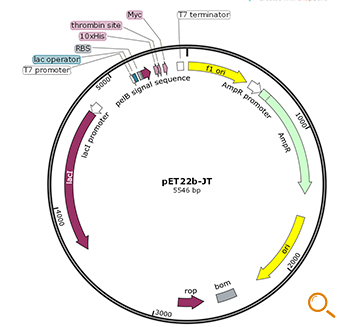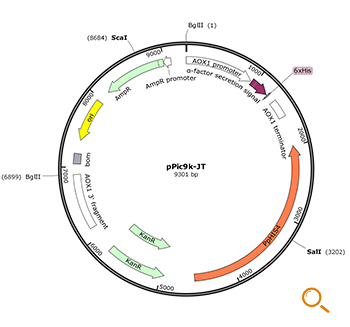How to choose a suitable expression vector?
In biomedical research and many other fields, there is a growing demand for recombinant proteins. To produce recombinant proteins, the protein-coding sequence is cloned into a suitable expression vector and then transformed into host cells. So exactly what is the expression vector?
Simply put, the expression vector is a DNA molecule that carries a specific gene into a host cell and uses the cell's protein synthesis machinery to produce the protein encoded by the gene. Expression vectors allow high-level expression of foreign genes in host cells, and through years of development, expression vectors have become a mature and popular biotechnology.
Due to its function, the expression vector must contain elements essential for gene expression. The well-known elements include a strong or normal promoter, a correct translation initiation sequence such as a ribosomal binding site (RBS) and an initiation codon, a termination codon, and a transcription termination sequence. Additionally, to facilitate protein purification after protein production, expression vectors usually have a purification tag, which is added to the protein sequence of interest. Finally, some expression vectors have specific elements, such as elements crucial for transformation or transfection.
When it comes to the expression vector, the cloning vector has to be mentioned. In essence, both the expression vector and the cloning vector are artificially constructed circular DNA sequences independent of chromosomes. Typically, an expression vector is more complex than a cloning vector. An cloning vector refers to a DNA molecule that carries foreign DNA into a host cell, replicates in the cell and produces many copies of the target gene. Cloning vectors contain elements crucial for self-replication but do not carry protein expression regulatory elements. By contrast, expression vectors contain both.
Currently, a variety of protein expression systems is available, such as E. coli, yeast, insect cells, and mammalian cells. Accordingly, there are many different expression vectors that can be used in different expression systems. The most common expression vectors are plasmids and viruses. The decision of which vector to use depends on expression system and many other factors. An appropriate expression vector will facilitate the successful expression of the target protein and, if necessary, protein purification.
When you are choosing an expression vector, you'd better keep these things in mind:
1. Expression System
You need to choose an expression vector that is specific for the expression system. Before choosing an expression vector, you should decide which system to express your protein of interest.

Pic. 1 shows the expression vector pET22b-JT that is used in the E. Coli expression system.

Pic. 2 shows the expression vector pPic9k-JT that is used in the yeast expression system.
2. Purification Tag
If you want to purify the protein after expression, the expression vector may include a purification tag such as His, Myc, FLAG, etc. In any case, whether a C-terminal or N-terminal tag is needed depends on the specific needs of experiments.
3. Applications of the Target Protein
Expression vectors may contain other tags and fusion proteins, according to downstream applications of the target protein. Sometimes, a specific tag is helpful to study the function of the target protein and protein-protein interactions. If you want to further understand the function of the target protein, tags and fusion proteins are useful tools that allow you to conduct Western Blotting, immunoprecipitation, pull-down assay (proteins binding in vitro assay) or other experiments.
4. Strength of the Promoter
Promoters are regions on DNA molecules that specifically bind to RNA polymerases and form transcription initiation complexes, which initiate downstream gene transcription. Promoters act as "switches", determining the activity of genes and controling the initiation and extent of gene expression. Therefore, promoters are necessary to construct expression vectors.
In some cases, a strong promoter is needed, while in others, a normal promoter is needed. For example, in yeast, TEF1 is a strong constitutive promoter, ADH1 is a medium strength constitutive promoter, and STE1 is a weak constitutive promoter. A proper promoter is strong enough to allow high product accumulation within host cells and can minimize any unfavorable impacts like toxicity on cell growth.
5. Selectable Marker
A selectable marker is a gene that confers a trait suitable for artificial selection to host cells containing the target gene (recombinant vector). In brief, the selectable marker gene help identify and screen the positive transformant (the cells that take in recombinant vector). The option of selectable marker depends on which host cell type you are using. Selectable markers are often antibiotic resistance genes. For example, beta-lactamase confers ampicillin resistance in bacterial hosts.
6. Vector Size
The only aspect to consider here is whether you are working with a large or small DNA fragment. Vectors must be relatively small molecules for the convenience of manipulation. Too large vectors may affect the replication and cause problems with stability. Usually, plasmids can cope with inserts up to 15 kb. But there are also special plasmids that cope with larger inserts.
The ultimate goal of any protein expression system is the production of recombinant proteins with high quantity and quality. Expression vectors help introduce foreign genetic material into host cells, allow the expression of target gene in host cells, and facilitate the identification and purification of target proteins. The expression vector plays a decisive role in the production of recombinant protein, so choosing an ideal expression vector is significant.
Cite this article
CUSABIO team. How to choose a suitable expression vector?. https://www.cusabio.com/c-20273.html






Understanding. Good.
Excellent article. Lucid expression of solid facts.